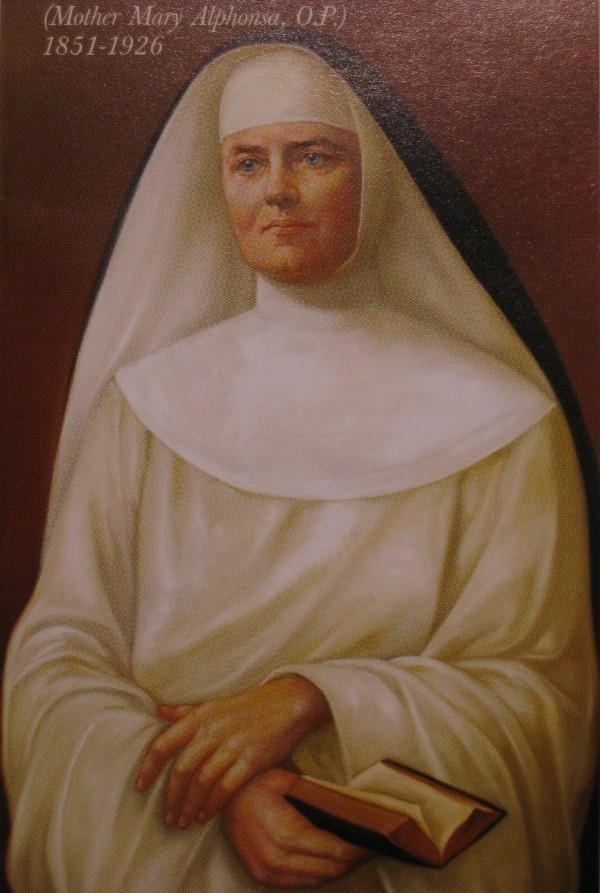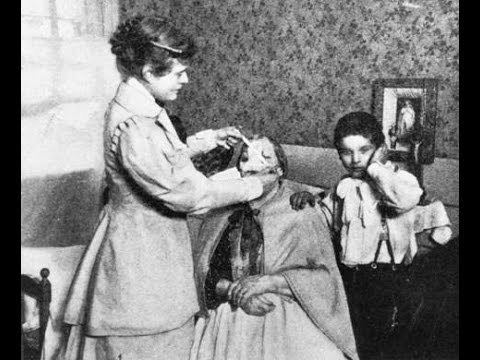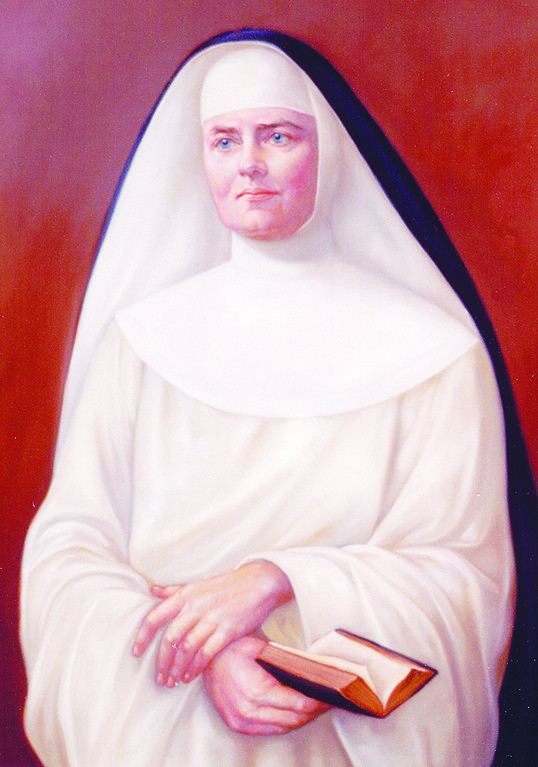Name Mother Alphonsa | ||
 | ||
Born Rose Hawthorne
May 20, 1851
Lenox, Massachusetts, United States ( 1851-05-20 ) Died July 9, 1926, New York City, New York, United States Parents Nathaniel Hawthorne, Sophia Hawthorne Grandparents Elizabeth Clarke Manning, Nathaniel Hathorne, Sr. Aunts Elizabeth Peabody, Mary Tyler Peabody Mann Books Along the Shore, Selected Writings, Along the Shore by Rose Ha Similar People Nathaniel Hawthorne, George Parsons Lathrop, Sophia Hawthorne, Elizabeth Peabody, Mary Tyler Peabody Mann | ||
Venerated in Roman Catholic Church | ||
Prayer for canonization of mother mary alphonsa
Rose Hawthorne Lathrop (May 20, 1851 – July 9, 1926) was an American writer. As Mother Mary Alphonsa in the 1900s, she was a Roman Catholic religious sister, social worker, and foundress.
Contents
- Prayer for canonization of mother mary alphonsa
- Early years and marriage
- Charity work and religious vocation
- Death and legacy
- References

Early years and marriage

Rose Hawthorne was born on May 20, 1851, in Lenox, Massachusetts, to Nathaniel Hawthorne and his wife Sophia. Sophia was assisted in the birth by her grandfather, Dr. Nathaniel Peabody. Hawthorne wrote about it to his friend, Horatio Bridge, comparing her to a book: "Mrs. Hawthorne published a little work, two months ago, which still lies in sheets; but, I assure you, it makes some noise in the world, both by day and night. In plain English, we have another little red-headed daughter—a very bright, strong, and healthy imp, but, at present, with no pretentions to beauty." On July 28, 1851, Sophia took Rose and her older sister, Una, to visit relatives in West Newton, Massachusetts.

Growing up, Rose lived in Massachusetts, Liverpool, London, Paris, Rome, and Florence. The family returned to Concord, Massachusetts, in 1860. There, her older brother Julian was enrolled in a co-educational school run by Franklin Benjamin Sanborn. Though their friend, the poet Ellery Channing, recommended the Hawthorne girls attend the same school, neither was enrolled. Sophia wrote: "We entirely disapprove of this commingling of youths and maidens at the electric age in school. I find no end of ill effect from it, and this is why I do not send Una and Rose to your school." Two years after Nathaniel's death in 1864, Rose was enrolled at a boarding school run by Diocletian Lewis in nearby Lexington, Massachusetts; she disliked the experience.

Later, the family moved to Germany and then to England. Sophia and Una died there in 1871 and 1877, respectively.

Rose married author George Parsons Lathrop in 1871. In 1876, they had a son, Francis. In the spring of 1879, the Lathrops purchased her family's former home in Concord, The Wayside, with borrowed funds. They moved out on the day Francis died of diphtheria at the age of five. They returned to New York City but moved to New London, Connecticut, in 1877 for George's health. There, they became involved with the Catholic summer school movement and collaborated on a book, A Story of Courage: A History of the Georgetown Visitation Convent. Rose tried to become an author in her own right and published a book of poems, Along the Shore, in 1888. Both she and George converted to Roman Catholicism in 1891. Following Francis' death he had become an alcoholic and was increasingly unstable. Una suspected he abused her mother. George also competed with Rose's brother Julian for control of Nathaniel Hawthorne's legacy. In 1883, Julian planned to publish Dr. Grimshawe's Secret, a manuscript left unfinished by their father, but Rose did not believe in its existence and suspected him of forgery or perpetrating a hoax. After Francis' death, Rose and Julian tried to end their quarreling and the Lathrops visited him in England in 1881. During that trip, however, they spent more and more time apart. They separated permanently in 1895; George died of cirrhosis three years later.
Charity work and religious vocation
Rose sought greater purpose in her life and spent time with the Sisters of Charity of Saint Vincent de Paul in Wellesley Hills, Massachusetts, and was inspired by their motto, "I am for God and for the poor." She was further inspired by the death of Emma Lazarus, whom she befriended in 1881. After Lazarus' death from cancer at age 38, Rose recalled that she was at least comfortable, unlike others who were poor. She wrote later, "Though I grieved deeply for her, I would not pity her, for she never knew unaided suffering, but every amelioration." As a source for her motivation to work with incurable impoverished people, she cited the story of a young seamstress who was too poor to afford medical treatment and instead had herself admitted to an institution for the insane on Blackwell's Island.
In the summer of 1896, Rose trained as a nurse at the then–New York Cancer Hospital, the first institution in the United States to provide training in treating cancer while general hospitals in the city did not admit patients with cancer. Later that year, she founded a charitable organization named after Saint Rose of Lima, Sister Rose's Free Home, to care for impoverished cancer patients. At first, she visited patients at home. In October 1896, she rented three rooms in a tenement on Scammel Street on the Lower East Side, a poor immigrant neighborhood, with the help of an assistant named Alice Huber. A Dominican priest, Father Clement Thuente, O.P., witnessed their work in February 1899 and encouraged them to join the Dominican order as tertiaries (Third Order Dominicans).
On December 8, 1900, Rose founded a new religious order, with the approval of Archbishop Michael A. Corrigan of New York. The order was named the Servants of Relief for Incurable Cancer; Rose became its first Mother Superior, with the name Mother Mary Alphonsa. Alice became known as Mother Rose. The order—now known as the Dominican Sisters of Hawthorne—opened a facility called St. Rose's Home on Water Street in Manhattan; it then moved to Cherry Street, before settling north of New York City in what is now Rosary Hill Home in Hawthorne.
Rose's brother, Julian, considered her decision martyrdom, writing, "Nothing less than the extreme would satisfy her thirst for self-sacrifice." When he was imprisoned for mail fraud, she traveled to Washington, D.C., on April 3, 1913, to ask President Woodrow Wilson to pardon him. Julian was angered by her intervention, and no pardon was granted.
Death and legacy
On July 8, 1926, Rose wrote various letters asking for donations until nearly 10 o'clock before going to bed. She died in her sleep on July 9, the day that would have been her parents' 84th wedding anniversary. She was buried on the grounds of the Motherhouse of the Dominican Sisters in Hawthorne, N.Y.
Rose received a medal from the National Institute of Social Sciences for "notable achievement" in 1914. In 1925, she was awarded an honorary Master of Arts from Bowdoin College. On April 18, 1926, the Rotary Club of New York presented her with a service medal as "soldier of love, a friend of the poor, organizer of rare ability, hope of the hopeless".
In 2003, Cardinal Edward Egan, Archbishop of the Archdiocese of New York, approved the movement for Rose's canonization. She now has the title "Servant of God" in the Catholic Church.
